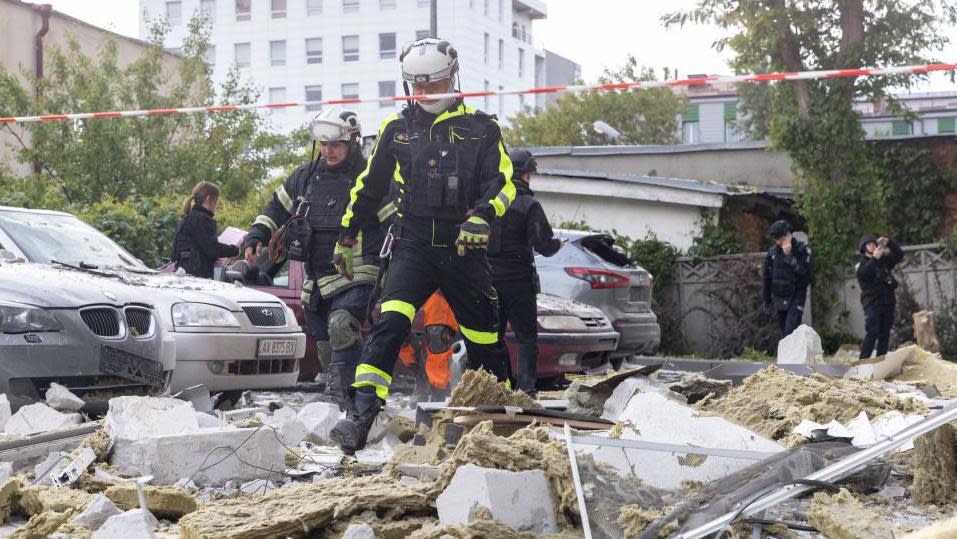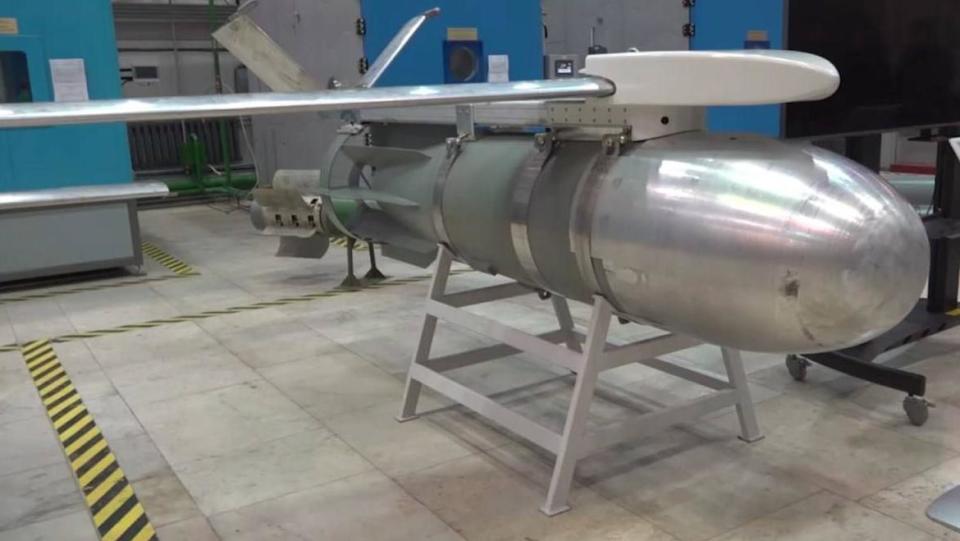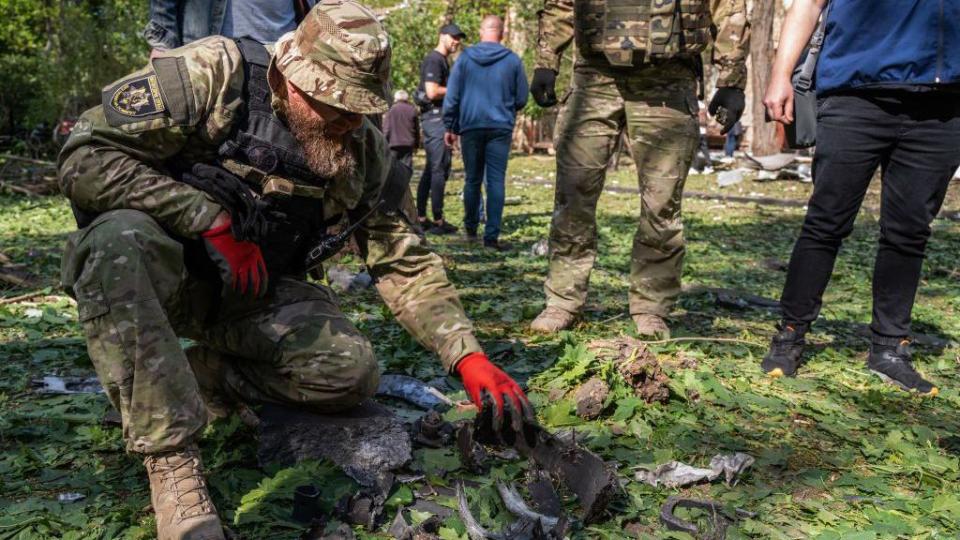Russia is more and more the usage of “glide bombs” – reasonable however extremely damaging ordnance – to progress its offensive in Ukraine.
Greater than 200 of them are idea to had been impaired in only a presen to pound Ukraine’s northern the town of Vovchansk right through Russia’s stream cross-border progress related Kharkiv.
Blackmail: It’s possible you’ll to find one of the vital main points on this piece nerve-racking
President Volodymyr Zelensky mentioned 3,000 such bombs had been dropped at the nation in March lonely.
Vovchansk police prominent Oleksii Kharkivsky has evident the have an effect on of drift bombs up near.

“There are no words to describe the aftermath of a glide bomb attack,” he says. “You arrive to see people who are lying there, torn apart.”
The accumulation utility of drift bombs through Russia is a rather contemporary building, one who has confirmed awful for Ukrainian forces in contemporary months.
Go with the flow bombs are constructed through including fold-out wings and satellite tv for pc navigation to impaired Soviet bombs. They’re reasonable however damaging.
A contemporary document through the Centre for Eu Coverage Research (CEPA) mentioned they had been decisive in February’s seize of the as soon as closely fortified key jap the town of Avdiivka.
Russian forces are actually the usage of drift bombs to assault the northern town of Kharkiv. Ukraine has to this point struggled to counter them.


The Vovchansk police prominent has been serving to to evacuate front-line border villages within the Kharkiv patch, the place Russian forces have just lately been advancing.
Parked up in his police automobile, he tells us the size of assaults has higher dramatically.
“Over the time six months, we had been collision through drift bombs slightly regularly, perhaps 5 to ten bombs according to presen… however this week we’ve had excess of ever,” he said.
Russia is able to stockpile glide bombs in high quantities because they are quite easily produced.
“The explosive part is essentially a conventional freefall iron bomb, of which Russia has hundreds of thousands in storage from the Soviet period,” says Prof Justin Bronk, airpower and military technology specialist at the Royal United Services Institute (Rusi).
“They are fitted with pop-out wings which, after the bomb is dropped, will flick out to allow it to glide much longer distances.”
Their attached satellite guidance system allows targeting of a stationary position with relatively high accuracy.
According to Prof Bronk, the mechanism of the bombs gives the Russians much of the functionality of a multi-million dollar missile, but for a fraction of the cost.
He says that glide kits – which are mass-produced and pretty mechanically simple – are added to Soviet bombs, of which the Russians have a plentiful supply – meaning the cost per weapon can be “someplace within the patch of $20,000 to $30,000 (£15,700-£23,600)”.
The concept is not new. The Germans deployed the Fritz-X during World War Two. In the 1990s the US military developed the Joint Attack Direct Munition, or JDAM, which added steerable tail fins and GPS guidance to traditional free-fall bombs. They have been used extensively since, including in Iraq and Afghanistan.


The destruction that the glide bombs create is extraordinary. The ordnance thought to be most commonly used for glide bombs is the FAB-1500, which weighs 1.5 tonnes.
For comparison, a Russian 152mm shell contains about 6.5kg of explosive material. Even the smallest glide bomb, the FAB-500, contains more than 200kg.
They turn even well-fortified Ukrainian positions into vulnerable targets.
Because glide bombs create far greater explosive power, they are more likely to cause cave-ins or fatalities even in quite well-fortified positions, Prof Bronk explains. The powerful blasts also have severe effects on the human body.
Glide bombs “are making Ukraine’s defensive technique tougher since the Russians can simply regularly bombard mounted positions till they’re long gone”, Prof Bronk says.
Ukrainian security analyst Mariia Zolkina tells the BBC that the use of glide bombs is a worrying development, and that the bombs are creating a “pristine month” for the military situation on the ground.
“They permit Russia to rub out Ukrainian defensive strains with out the usage of their infantry,” Ms Zolkina says. “They’ve an absolutely other impact to artillery hearth and even missile moves.”
George Barros from the US-based Institute for the Find out about of Conflict (ISW) says that week Ukraine’s status is tricky, any other being worried building may well be simply across the nook.
He notes there’s proof {that a} manufacturing facility about 400km (250 miles) east of Moscow is putting in place a manufacturing fold in a position to churning out drift bombs weighing greater than 3 tonnes.
If drift bombs of that dimension had been to start out being automatically dropped on Ukrainian positions, the have an effect on could be giant – each on fortifications and the morale of the community looking to retain them.


So what can be done to counter glide bombs?
Prof Bronk says that intercepting the bombs mid-flight is not a viable solution because of the sheer number the Russians have at their disposal. “You could possibly deplete thru all of the to be had breeze defence ammunition too temporarily,” he says.
The only solution, bar a ground incursion, is to target the planes that drop them, either in flight or on the ground.
But that comes with significant risks.
The US Patriot surface-to-air missile launcher system can shoot the fighter-bombers down – but only if it is positioned near the front lines. This carries the risk of being spotted by Russian drones and hit with ballistic missiles, Prof Bronk says – something that happened to two launchers earlier this year.
This leaves the option of using long-range missiles or drones to target Russian air bases.
It is a method Ukraine has been employing. In April, Kyiv claimed to have used a barrage of drones to destroy at least six military aircraft and badly damage eight others at an airfield in Russia’s southern Rostov region.
This solution, however, is not without its problems. The US – the biggest provider of Ukrainian military aid – prohibits Kyiv from using any of its weapons systems on internationally recognised Russian territory. While this does not include Crimea or occupied Ukraine, it does mean that airfields inside Russia are off-limits.
So, for now, it seems there is no easy answer for Ukraine.
President Volodymyr Zelensky has repeatedly called for more air defence missiles and the supply of modern fighter jets.
But for now, Mariia Zolkina says morale has been affected by the increased use of glide bombs.
“The military do not feel safe because their fortifications can’t protect them, while civilians living in Kharkiv, people used to living under shelling, can’t escape a bomb which can destroy a seven-storey building.”











